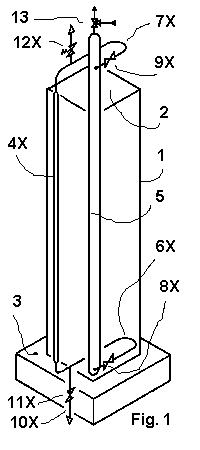|
|
The Main Structure Cooling System is described below using an example and Fig. 1. The latter shows an isometric view of an outline of a high-rise building with four vertical walls [only their contours (1) are shown] that encompass a square horizontal section (2). The building is erected on a foundation (3). Vertical steel tubes are incorporated on the total height of the façades of all said walls; one only of them (4X) is shown in the Fig. 1. They are filled with water and act as risers in case of fire. Their external parts are insulated to prevent freezing of water stored inside. An internal kernel of the building (not shown in the Fig. 1) is selected as a previously mentioned, in this example single, protected room. Its square horizontal section is placed concentrically within the corresponding section of the external walls. This protected room runs across all stories of the building from its bottom to the top. Inside are placed all structures that cannot be easily cooled by individual internal channels as well as structures that must be protected by solid barriers in order to comply with any related rules. The central downcomer (5) is also placed within the protected room. Conversely, any easy igniting or burning materials shall be kept outside the protected room. |
